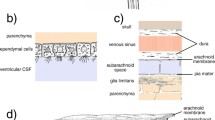Summary
There is a basic alteration in cerebrospinal fluid (CSF) movement and absorption with the development of chronic communicating hydrocephalus. The transfer of radioactive albumin from the CSF space into the blood is delayed. — Ventricular entry associated with persistence (“stasis”) of the radiopharmaceutical corresponds with the syndrome of normal pressure hydrocephalus (NPH) and in clinical improvement with CSF diversionary shunts. As demonstrated by autoradiographic investigations the concentration gradient of radioactivity from the ependymal surface to depth in the periventricular area supports the concept that transependymal migration is an important mechanism of egress of CSF from the CSF space in communicating hydrocephalus.
Résumé
Le développment d'une hydrocéphalie communicante introduit une altération fondamentale dans la circulation et l'absorption du liquide céphalo-rachidien (LCR). Ainsi qu'il a été démontré par des investigations autoradiographiques, le degré de concentration radioactive de la surface épendymaire jusque dans les zones périventriculaires étaye la théorie selon laquelle la migration trans-épendymaire est un important mécanisme de sortie du liquide céphalo-rachidien hors de l'espace sousarachnoïdien dans les cas d'hydrocéphalie communicante. Le transfert de la substance radioactive de l'espace sousarachnoïdien dans le sang est retardé dans les cas d'hydrocéphalie. Ceci représente une autre méthode permettant de distinguer les malades porteurs d'une hydrocéphalie communicante des cas normaux. La corrélation avec les données cliniques révèle que le passage ventriculaire associé à une persistance (stase) de la radioactivité corresond au symptôme d'hydrocéphalie avec pression normale et amélioration clinique par les shunts de dérivation.
Zusammenfassung
Die Liquorzirkulation ist beim kommunizierenden Hydrocephalus grundlegend verändert. Entsprechend autoradiographischen Untersuchungen unterstützt der Radioaktivitätskonzentrationsabfall vom Ependym Richtung periventrikulärem Gewebe die Hypothese, daß die transependymale Bewegung ein wichtiger Mechanismus für das Verlassen des Liquors aus den Liquorräumen beim kommunizierendem Hydrocephalus ist. — Der Transport von radioaktiven Substanzen vom Liquorraum ins Blut ist beim Hydrocephalus verlangsamt. Diese Beobachtung ergibt eine andere Methode, Patienten mit kommunizierenden Hydrocephalus von normalen zu unterscheiden. Die Korrelation der Isotopencisternographie mit den klinischen Ergebnissen zeigt, daß Radiopharmazeutikumeintritt mit Verweilen in den Ventrikeln („Stasis”) mit den Symptomen des „Normal Pressure Hydrocephalus” (NPH) und mit klinischer Besserung nach Liquorshuntoperation übereinstimmt.
Similar content being viewed by others
References
Adams, R.D.: Further observations on normal pressure hydrocephalus. Proc. roy. Soc. Med. 59, 1135–1140 (1966)
Bering, E.A.: Use of phenolsulfonphthalein in clinical evaluation of hydrocephalus. J. Neurosurg. 13 587–595 (1956)
DeLand, F.H., James, A.E., Ladd, D.J., Konigsmark, B.W.: Normal pressure hydrocephalus: a histologic study. Amer. J. clin. Path. 58, 58–63 (1972)
DiChiro, G.: Observations on circulation cerebrospinal fluid. Acta radiol. Diag. 5, 988–1022 (1966).
James, A.E., Jr., DeLand, F.H., Hodges, F.J., III, Wagner, H.N., Jr.: Cisternography: its role in normal pressure hydrocephalus. J. Amer. med. Ass. 213, 1615–1622 (1970)
James, A.E., Jr., New, P.F.J., Heinz, E.R., Hodges, F.J., III, DeLand, F.H.: A cisternographic classification of hydrocephalus. Amer. J. Roentgenol. 115, 39–49 (1972)
James, A.E., Jr., Strecker, E.P., Bush, M.: A catheter technique to produce communicating hydrocephalus. Radiology 106, 437–439 (1973)
Lorenzo, A.V., Page, L.K., Watters, G.V.: Relationship between cerebrospinal fluid formation, absorption, and pressure in human hydrocephalus. Brain 93, 679–692 (1970)
Milhorat, T.H., Clark, R.G., Hammock, M.K.: Structural, ultrastructural, and permeability changes in the ependyma and surrounding brain favoring equilibrium in progressive hydrocephalus. Arch. Neurol. 22, 397–407 (1970)
Strecker, E.P., Scheffel, U., Kelly, F., James, A.E., Jr.: Alterations in CSF absorption in experimental communicating hydrocephalus: evaluation of transfer of radioactively labelled albumin from the subarachnoid space to the plasma. Neurology 23, 854–864 (1973)
Strecker, E.P., Bush, M., James, A.E., Jr.: Cerebrospinal fluid imaging as a method to evaluate communicating hydrocephalus in dogs. Amer. J. vet. Res. 34, 101–104 (1973)
Strecker, E.P., Merz, T., Konigsmark, B.W., James, A.E., Jr.: Cerebrospinal fluid and absorption in communicating hydrocephalus: autoradiographic observations. Neurology (in press)
Author information
Authors and Affiliations
Rights and permissions
About this article
Cite this article
Strecker, EP., James, A.E. The evaluation of cerebrospinal fluid flow and absorption: Clinical and experimental studies. Neuroradiology 6, 200–205 (1973). https://doi.org/10.1007/BF00335324
Issue Date:
DOI: https://doi.org/10.1007/BF00335324




